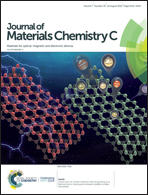Binder-free heat dissipation films assembled with reduced graphene oxide and alumina nanoparticles for simultaneous high in-plane and cross-plane thermal conductivities†
Abstract
Reduced graphene oxide (rGO) is an attractive material for heat dissipation films due to its high thermal conductivity. However, stacked rGO nanosheets generally suffer from low cross-plane thermal conductivity owing to inter-sheet gaps, which is an obstacle for implementing effective heat dissipation films. To resolve this issue, here, we propose multilayered films consisting of GO nanosheets and alumina nanoparticles using a spin-assisted layer-by-layer deposition method. Charged moiety-supplemented alumina nanoparticles are uniformly inserted between horizontally oriented GO nanosheets to compensate for the mitigated thermal transport encountered in GO-only stacked films. By virtue of successful electrostatic binding between GO nanosheets and functionalized alumina nanoparticles, alternately stacked films are readily grown up to ∼10 μm in thickness. After thermal reduction treatment, in particular, thermally non-conductive residual functional groups are completely removed while securing the structural intactness in layered stacking, and rGO/alumina stacked films exhibit a remarkably high in-plane thermal conductivity of 565 W m−1 K−1, which is even greater than that of Cu films by a factor of 1.4. In particular, due to the formation of a well-interconnected, ladder-like architecture of alumina nanoparticles between rGO nanosheets, the assembled film exhibits a cross-plane thermal conductivity of 18.1 W m−1 K−1, which outperforms rGO-stacked layers by two orders of magnitude. As a result, rGO/alumina films can show efficient heat dissipation performances by significantly reducing the maximum operating temperature of high-power light-emitting devices.



 Please wait while we load your content...
Please wait while we load your content...